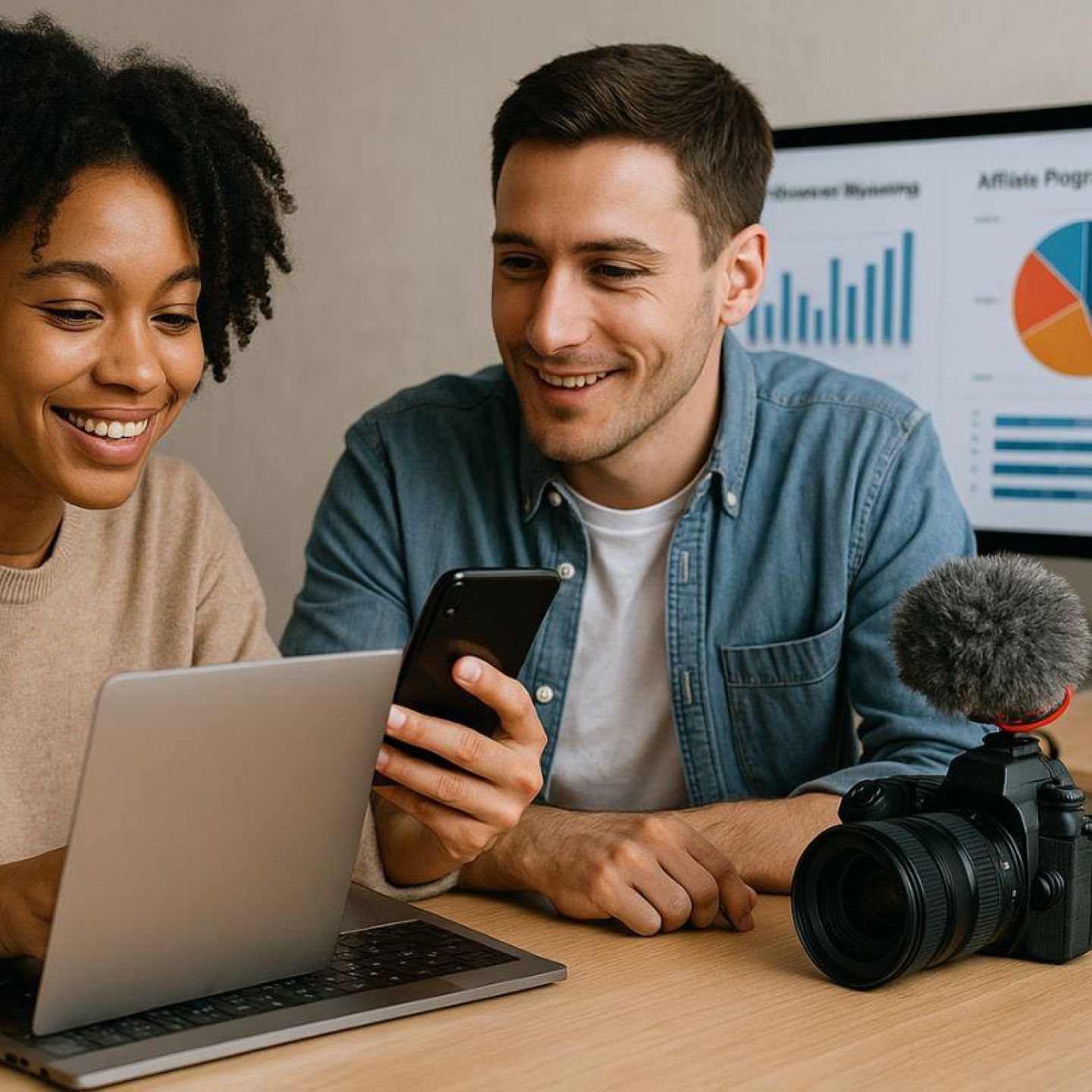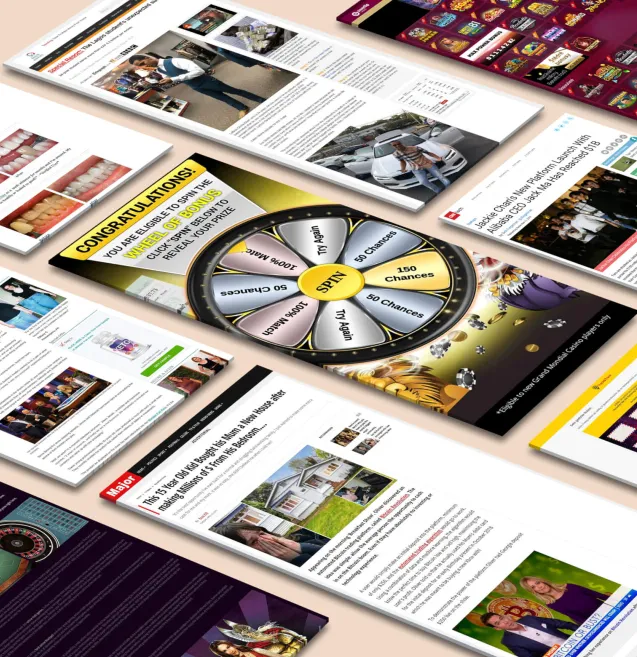
Our tools monitor millions of native, push, pop, and TikTok advertising campaigns.
Get StartedThe world of digital marketing is undergoing a significant change as we enter 2025. Affiliate partnerships in 2025 are no longer limited to traditional performance-based models or individual influencer collaborations. Instead, brands are embracing a powerful combination that brings together the best aspects of both approaches.
Creator + affiliate hybrids represent the new frontier of digital marketing partnerships. These innovative models transform content creators into dual-purpose brand partners who simultaneously build authentic connections with their audiences while driving measurable sales results. You're witnessing creators evolve beyond simple brand ambassadors into sophisticated revenue generators who understand both storytelling and conversions" target="_blank" rel="noreferrer noopener">conversion optimization.
The numbers tell a compelling story: affiliate marketing is projected to reach $12 billion globally, while influencer collaborations are expected to hit $32.5 billion by 2025. This convergence isn't coincidental—it's strategic. Brands recognize that creator affiliate marketing delivers something neither traditional affiliate nor influencer marketing can achieve alone: authentic engagement that converts.
These evolving affiliate strategies are reshaping how you think about partnership structures. Creators now serve as both brand advocates who build trust and direct sales drivers who generate immediate revenue. This dual functionality creates unprecedented opportunities for brands to maximize their marketing investments while providing creators with diversified income streams that reward both creativity and performance.
In fact, the rise of hybrid models has led to the emergence of some of the best affiliate programs for marketers and creators in 2025, offering lucrative commission rates and flexible payout details. For instance, platforms like Anstrex allow affiliates to earn significant income from referred customers, showcasing the potential of these evolving partnerships.
The era of choosing between influence and sales has ended—2025 belongs to partnerships that deliver both.
Creator affiliate marketing is changing the way brands work with digital partners. In this new model, content creators become versatile marketing tools who not only promote products but also directly contribute to sales.
In hybrid partnerships, creators stay true to their personal style while earning commissions based on their performance. Influencer affiliates share genuine experiences with products through captivating content, seamlessly incorporating trackable links or discount codes that turn their followers into paying customers.
The mechanics behind this approach are simple yet effective:
Brands benefit from this dual approach by accessing both the trust-building power of influencer content and the measurable ROI of affiliate marketing. You get comprehensive campaign data showing not just engagement metrics, but actual revenue attribution. Creators gain financial incentives aligned with their content performance, encouraging them to produce material that genuinely drives conversions.
This model particularly thrives with micro and nano-influencers who maintain close relationships with their audiences. Their recommendations carry authentic weight, translating directly into higher conversion rates compared to traditional advertising approaches. The result is a sustainable partnership structure where creator success directly correlates with brand revenue growth.
Hybrid compensation models are changing how brands set up partnerships with creators. Instead of relying solely on commissions like before, brands are now adopting more complex payment structures that include both upfront fees and performance-based rewards. This combination ensures that creators have a steady income while still being motivated to achieve results.
Tiered commission rates are an effective way to motivate creators and reward those who perform exceptionally well. With this system, creators who generate higher sales volumes earn progressively better commission percentages. For example, they might start with a commission rate of 5-8% and then move up to 15-20% for top performers. This structure encourages creators to consistently put in effort and adds long-term value to the partnership.
Multi-action compensation goes beyond just tracking sales and recognizes creators for various ways they engage with their audience:
Revenue sharing agreements prolong partnerships by giving creators ongoing commissions from repeat customers they initially referred. This means that collaborations can turn into long-lasting business relationships where creators benefit from the lifetime value of customers.
These new compensation structures have a direct impact on what motivates creators. By offering them multiple sources of income and clearer paths to earning more, these structures encourage creators to invest more time and creativity into their partnerships. As a result, we can expect to see more genuine content and stronger support for brands from creators.
Authenticity in marketing has become the cornerstone of successful Affiliate Partnerships in 2025: Creator + Affiliate Hybrids. You'll notice that consumers increasingly gravitate toward raw, unfiltered content that feels genuine rather than polished advertisements. This shift represents a fundamental change in how brands approach their messaging strategy.
User-generated content drives purchase decisions with remarkable effectiveness. When you see a creator sharing their honest experience with a product—complete with imperfections and real-world usage scenarios—you're witnessing the power of authentic storytelling. Research consistently shows that UGC generates conversion rates up to 4.5% higher than traditional branded content.
Small creators excel at crafting trust-building content through their intimate connection with their audiences. You'll find that nano-influencers with 1,000-10,000 followers often outperform mega-influencers in engagement rates and conversion metrics. Their secret lies in:
The effectiveness stems from perceived relatability. When you follow a creator who shares your interests, lifestyle, or challenges, their product recommendations carry the weight of a trusted friend's advice. This authentic approach transforms affiliate partnerships from transactional relationships into community-driven advocacy that benefits both creators and brands through sustained engagement and loyalty.
Social commerce integration has transformed how creators monetize their content, eliminating the friction between discovery and purchase. Platforms now embed shopping functionality directly into the creator experience, allowing audiences to buy products without leaving their favorite apps.
Here are some examples of how different platforms have integrated commerce into their social experiences:
These platform integrations have reduced the traditional barrier of redirecting audiences to external websites. You experience a streamlined shopping journey where inspiration and purchase happen within seconds of each other.
Performance-driven affiliate marketing has transformed how brands measure success in creator partnerships. You can now track every touchpoint in the customer journey, moving beyond traditional last-click attribution models that only credited the final interaction before purchase.
Modern ROI tracking systems capture the complete conversion path:
AI-powered platforms like Creator.co and Grin analyze millions of data points to identify creators who align with your target audience demographics and purchasing behaviors. These systems evaluate engagement quality, audience authenticity, and historical conversion rates to predict campaign performance before you invest.
Machine learning algorithms optimize campaigns in real-time by:
You gain unprecedented visibility into which creators generate actual revenue versus vanity metrics. Advanced analytics dashboards show cost per acquisition, return on ad spend, and attribution windows that extend up to 90 days post-engagement, giving you concrete data to justify influencer marketing budgets and scale successful partnerships.
Affiliate Partnerships in 2025: Creator + Affiliate Hybrids thrive across multiple content formats, with creators strategically placing affiliate links throughout their digital ecosystem. Short-form video marketing dominates the landscape, with TikTok Reels and Instagram Stories serving as primary vehicles for seamless affiliate integration.
Live shopping streams represent the fastest-growing segment of affiliate content, combining real-time engagement with immediate purchase opportunities. Creators host interactive sessions where viewers can ask questions, see products in action, and access exclusive discount codes simultaneously.
Email newsletters have experienced a renaissance as creators build direct relationships with subscribers. These intimate channels allow for detailed product reviews, exclusive affiliate offers, and personalized recommendations that convert at higher rates than social media posts.
Podcast integrations offer another lucrative avenue, with creators weaving affiliate mentions into conversational content that feels natural and trustworthy. The audio format creates deeper connections between creators and audiences, leading to stronger purchase intent when affiliate products align with discussed topics.
Community-first marketing has changed the way brands work with affiliates. Instead of focusing on how many followers someone has, the emphasis is now on how engaged their audience is. Nano-influencers, who have between 1,000 and 10,000 followers, and micro-influencers, with 10,000 to 100,000 followers, are proving to be highly effective because they have strong connections within their communities.
These smaller creators have genuine relationships with their followers, treating them like friends instead of just consumers. When a nano-influencer promotes your product using a unique link, it's as if they're personally recommending it to their close circle. Their audience trusts these creators because they have established authentic connections through relatable content.
Long-term partnerships with niche influencers benefit both parties involved. Rather than running individual campaigns, brands choose to build ongoing relationships where creators become true advocates for the brand. For example, if a fitness nano-influencer endorses the same supplement brand over a period of six months, it enhances credibility and leads to consistent sales.
The data backs up this strategy:
These creators excel at community building rather than broadcasting. They respond to comments, create content based on follower requests, and maintain active dialogue with their audience. When they share affiliate products, the recommendation feels like advice from a trusted friend, not a sales pitch from a distant celebrity.
Creator empowerment has become the cornerstone of successful affiliate partnerships, requiring brands to strike a delicate balance between maintaining brand integrity and allowing authentic creative expression. You'll find that the most effective partnerships emerge when creators feel trusted to produce content that resonates with their unique audience while respecting brand values.
Successful brands provide creative freedom guidelines that outline non-negotiables without stifling creativity. These frameworks typically include:
The key lies in establishing collaborative rather than restrictive relationships. Brands like Glossier and Patagonia excel at this approach by providing creators with brand storytelling frameworks while encouraging personal interpretation and authentic integration.
Smart affiliate programs now include creator onboarding sessions where brand representatives and influencers align on expectations together. This collaborative approach reduces content revisions by 60% and increases creator satisfaction scores significantly.
You should focus on creating guidelines that feel like creative inspiration rather than limitations. When creators understand the "why" behind brand standards, they naturally produce content that maintains authenticity while protecting brand reputation. This empowerment model transforms creators from external contractors into genuine brand ambassadors who take ownership of campaign success.
Maximizing reach in 2025 requires a strategic blend of compelling storytelling and performance-driven incentives. Brands are discovering that hybrid affiliate strategies create exponential impact when creators weave authentic narratives around products while maintaining clear sales objectives. This approach transforms traditional product placement into engaging stories that resonate with audiences on emotional levels.
The power lies in combining influencer storytelling with direct sales incentives. When a fitness micro-influencer shares their genuine transformation journey while offering followers a discount code, you get both inspiration and immediate purchasing motivation. This dual approach widens audience impact by capturing viewers who connect with the story and those ready to buy immediately.
Affiliate Partnerships in 2025: Creator + Affiliate Hybrids thrive on diversity. Successful brands deploy multiple creator types across their campaigns:
Each creator type serves distinct audience segments, creating comprehensive market penetration. A beauty brand might partner with skincare experts for product education, lifestyle micro-influencers for daily use scenarios, and nano-influencers for authentic testimonials. This multi-layered approach ensures your message reaches diverse demographics through trusted voices, amplifying both brand awareness and conversion potential across various consumer touchpoints.
Affiliate marketing technology has become the backbone of successful creator-affiliate partnerships, transforming how brands discover, manage, and optimize their campaigns. Modern platforms integrate sophisticated algorithms that match brands with ideal creators based on audience demographics, engagement patterns, and conversion history.
AI-driven discovery tools eliminate the guesswork from influencer selection. These systems analyze millions of data points to identify creators whose audiences align perfectly with your target market. You can now pinpoint nano-influencers in specific niches who consistently drive sales, rather than relying on follower counts alone.
Campaign management platforms streamline the entire partnership lifecycle:
Predictive analytics represent the cutting edge of Affiliate Partnerships in 2025: Creator + Affiliate Hybrids. These tools forecast trending products, optimal posting times, and seasonal demand fluctuations. You can anticipate which creators will perform best during specific campaigns before launching them.
Machine learning algorithms continuously optimize campaign parameters, adjusting bid strategies and creator recommendations based on performance data. This technology-driven approach enables you to scale partnerships efficiently while maintaining the authentic relationships that make hybrid models so effective.
The result? Campaigns that adapt in real-time to market conditions while preserving the genuine creator connections that drive conversions.
Receive top converting landing pages in your inbox every week from us.
Tips & Tricks
Year-end is the perfect time to refine your affiliate marketing approach and boost conversions. Learn five proven strategies to optimize campaigns, enhance ad performance, and take advantage of seasonal buyer intent. Discover actionable tips to maximize revenue and end the year on a high note. Perfect for affiliates ready to turn Q4 momentum into measurable success.
David Kim
7 minNov 25, 2025
Tips & Tricks
This blog shares proven strategies to help affiliates increase their sales before the year ends. It covers actionable tips on optimizing campaigns, leveraging seasonal trends, and refining ad creatives for higher conversions. Readers will discover how to make the most of Q4 opportunities and finish the year strong. Perfect for affiliate marketers aiming to maximize profits during the busiest shopping season.
Priya Kapoor
7 minNov 22, 2025
Announcement
This blog explores the emerging trend of affiliate partnerships with major streaming platforms and how they’re reshaping digital marketing. It explains how brands and affiliates can collaborate to tap into engaged audiences through sponsored content and integrated promotions. Readers will learn about partnership models, monetization opportunities, and key strategies for success in this growing space. Perfect for marketers eager to stay ahead in the evolving world of affiliate marketing.
Samantha Reed
7 minNov 20, 2025




